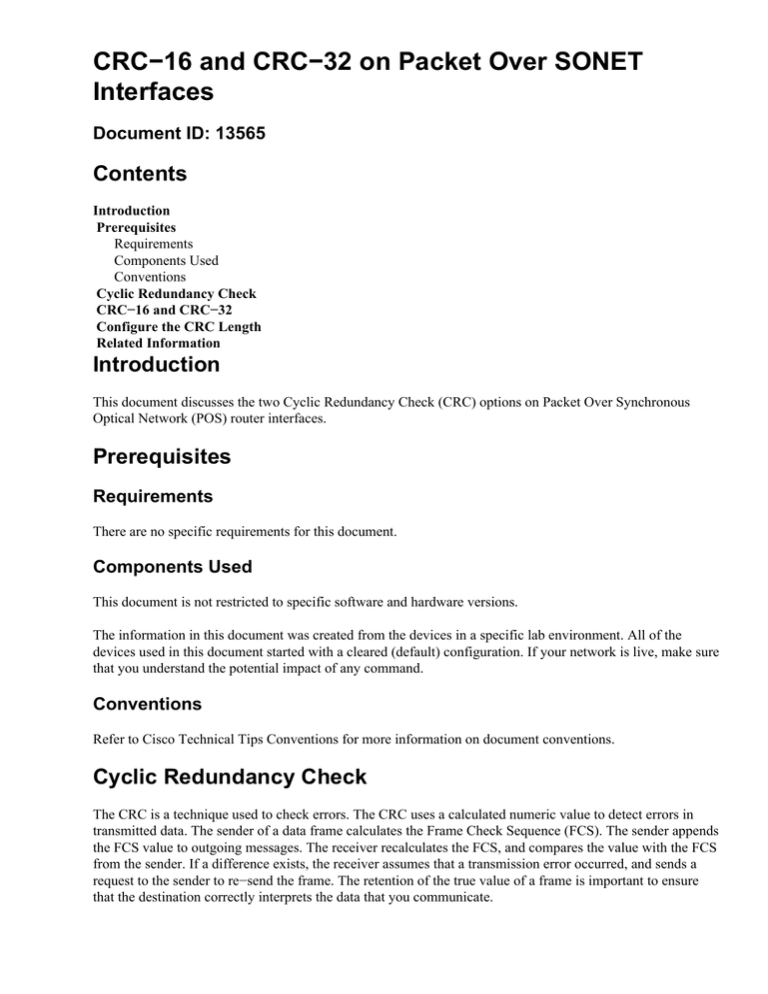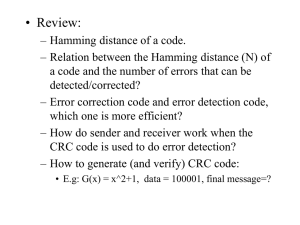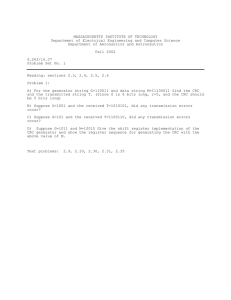
CRC−16 and CRC−32 on Packet Over SONET
Interfaces
Document ID: 13565
Contents
Introduction
Prerequisites
Requirements
Components Used
Conventions
Cyclic Redundancy Check
CRC−16 and CRC−32
Configure the CRC Length
Related Information
Introduction
This document discusses the two Cyclic Redundancy Check (CRC) options on Packet Over Synchronous
Optical Network (POS) router interfaces.
Prerequisites
Requirements
There are no specific requirements for this document.
Components Used
This document is not restricted to specific software and hardware versions.
The information in this document was created from the devices in a specific lab environment. All of the
devices used in this document started with a cleared (default) configuration. If your network is live, make sure
that you understand the potential impact of any command.
Conventions
Refer to Cisco Technical Tips Conventions for more information on document conventions.
Cyclic Redundancy Check
The CRC is a technique used to check errors. The CRC uses a calculated numeric value to detect errors in
transmitted data. The sender of a data frame calculates the Frame Check Sequence (FCS). The sender appends
the FCS value to outgoing messages. The receiver recalculates the FCS, and compares the value with the FCS
from the sender. If a difference exists, the receiver assumes that a transmission error occurred, and sends a
request to the sender to re−send the frame. The retention of the true value of a frame is important to ensure
that the destination correctly interprets the data that you communicate.
CRC−16 and CRC−32
Request for Comments (RFC) 2615
defines the use of the Point−to−Point Protocol (PPP) over SONET/
Synchronous Digital Hierarchy (SDH). Here is how this RFC specifies when a POS interface can use the
16−bit CRC (CRC−16) and when it can use the 32−bit CRC (CRC−32):
"Regarding the FCS length, with one exception, the 32−bit FCS must be used for all SONET/SDH rates. For
Synchronous Transport Signal (STS)−3c− Systems Process Engineering (SPE)/VC−4 only, the 16−bit FCS
may be used, although the 32−bit FCS is recommended. The FCS length is set by provisioning and is not
negotiated."
RFC 2615 requires (and recommends) the 32−bit CRC. The 32−bit CRC is far superior in the detection of
certain types of errors than a 16−bit CRC. The less robust CRC−16 can fail to detect a bit error on links that
can transmit Gigabits of data per second.
You can do the actual CRC computation in hardware with no performance implication for either CRC length.
Therefore, although the 32−bit CRC adds more overhead, Cisco recommends this length of CRC on Optical
Carrier−3 (OC−3) interfaces.
Figure 1 indicates the order of operation on a Cisco POS interface, and when the interface generates the CRC:
Figure 1 Order of Operation on a Cisco POS Interface
Configure the CRC Length
Ensure that both router ends of a POS link use the same CRC. Mismatched CRC settings are one
configuration parameter to check when a POS interface stays up/down. Use the show interface command to
confirm your settings. In order to comply with RFC 2615, all Cisco POS interfaces support CRC−32.
Higher−rate interfaces use CRC−32 as the default.
Here is the output from a 4xOC12 POS line card for the Gigabit Switch Router (GSR):
RTR12410−2#show interface pos 8/0
POS8/0 is up, line protocol is up (looped)
Hardware is Packet over SONET
MTU 4470 bytes, BW 622000 Kbit, DLY 100 usec, rely 255/255, load 1/255
Encapsulation HDLC, crc 32, loopback set (internal)
Keepalive set (10 sec)
Scramble disabled
Last input 00:00:00, output 00:00:00, output hang never
Last clearing of "show interface" counters never
Queueing strategy: fifo
Output queue 0/40, 0 drops; input queue 0/75, 0 drops
5 minute input rate 0 bits/sec, 0 packets/sec
5 minute output rate 0 bits/sec, 0 packets/sec
101418 packets input, 7853571 bytes, 0 no buffer
Received 0 broadcasts, 31 runts, 0 giants, 0 throttles
0 parity
213 input errors, 128 CRC, 0 frame, 0 overrun, 54 ignored, 0 abort
101414 packets output, 7853571 bytes, 0 underruns
0 output errors, 0 applique, 0 interface resets
0 output buffer failures, 0 output buffers swapped out
3 carrier transitions
Use the crc command to configure a non−default value, as shown here:
RTR12410−2(config)#interface pos 8/0
RTR12410−2(config−if)#crc ?
16 crc word−size
32 crc word−size
Related Information
• Optical Product Support Pages
• Packet over SONET (POS) Line Card Installation and Configuration Notes
• SONET Port Adapters
• Technical Support & Documentation − Cisco Systems
Contacts & Feedback | Help | Site Map
© 2014 − 2015 Cisco Systems, Inc. All rights reserved. Terms & Conditions | Privacy Statement | Cookie Policy | Trademarks of
Cisco Systems, Inc.
Updated: May 02, 2005
Document ID: 13565




